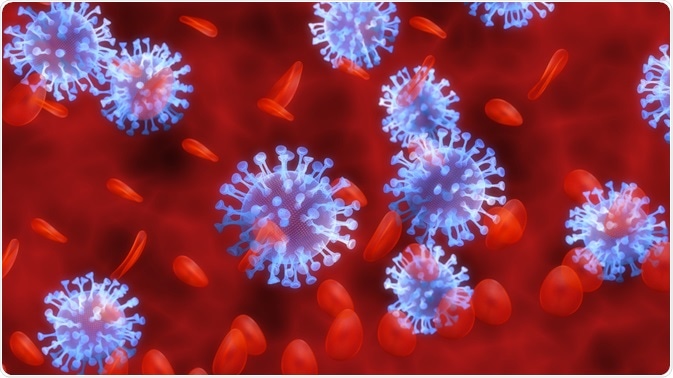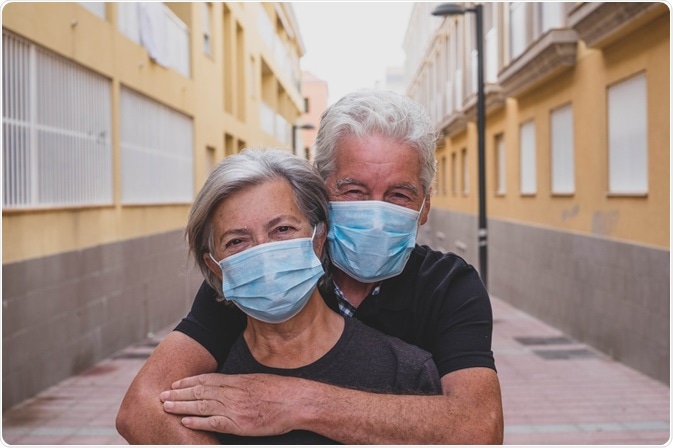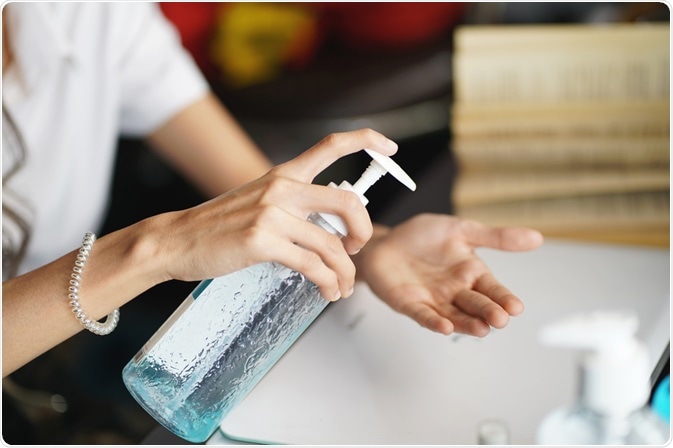COVID-19 is a severe respiratory illness caused by a novel coronavirus called severe acute respiratory syndrome coronavirus 2 (SARS-CoV-2). As the virus became a global pandemic, there were widespread changes to daily life to stop the spread of the virus.

Image Credit: jaras72/Shutterstock.com
Any treatment available is supportive, meaning it does not treat the virus specifically, but supports the body as it fights off the infection naturally.
Measures to prevent the spread of the virus have included physical and social distancing, more rigorous hygiene practices, and wearing protective facial coverings.
As the pandemic develops, advice on how to effectively utilize these preventative measures is developing, too. The current advice on all preventative measures is detailed below.
Face masks and coverings
Face masks will not prevent the spread of SARS-CoV-2 on their own. They must be used in conjunction with other preventative measures. There are several different types of face masks available, and as such, there is different advice on how to wear, remove, and wash them safely.
Face masks are worn primarily to protect other people from the wearer, who may be asymptomatic or presymptomatic and able to pass on the virus unknowingly. It is important to understand the difference between pre- and asymptomatic people.
Presymptomatic means a person is not currently showing symptoms but will become sick and show symptoms in the future. Asymptomatic means a person is infected but is not currently showing symptoms and will never show symptoms.
Both pre- and asymptomatic people are capable of passing on SARS-CoV-2, although presymptomatic people are more likely to spread the virus. This is why facial coverings are necessary for everyone when they are in public spaces. A person cannot be entirely certain whether they are pre- or asymptomatic and unknowingly spreading the virus.

Image Credit: Perfect Wave/Shutterstock.com
Medical masks
The World Health Organization (WHO) recommends that medical masks should be worn by:
- Those working in healthcare facilities
- Those with symptoms
- Those awaiting test results
- Anyone who has tested positive
- Those caring for people with COVID-19 symptoms
- People aged 60 and over due to increased risk of severe COVID-19
- People with underlying health conditions that increase their risk of severe COVID-19
Before putting on a medical mask, clean the hands with alcohol hand rub or soap and water for 20 to 60 seconds. Do not use a mask that has been worn before or is damaged, and do not touch the mask while it is being worn.
To put on a medical mask, only touch the straps behind the ears. Medical masks usually have a metal strip that should be pinched when the mask is first put on to bend to the shape of your nose. This prevents any gaps in the mask that may allow infected particles to enter or leave the mouth and nose.
To take off a medical mask, clean the hands, and remove with the straps. Do not touch the front of the mask. Lean forward and pull the mask away from the face.
Dispose of medical masks as soon as they are removed into a closed bin or container. They are single-use only.
Fabric masks
Fabric masks, or non-medical masks, should be used by the general public (who do not have underlying health conditions and are under 60).
The important aspects of a fabric mask are breathability and fit. Fabric masks should consist of three layers of fabric. The WHO recommends that the inner layer is an absorbent material, the middle layer is a non-woven, non-absorbent material and the outer layer is a non-absorbent material. The mask should be an appropriate shape to fit closely over an individual’s nose, cheeks and chin, and should be held in place without having to be adjusted.
Before putting on a fabric mask, it is important to wash the hands. Do not use the mask if it is damaged or dirty and change the mask if it becomes dirty or wet when it is being worn.
Make sure that it covers the mouth and nose, as this is where the virus can enter and exit the body. While wearing the mask, do not touch the front of the mask and adjust the mask using the straps. Do not touch the front of the mask before, while, or after wearing a mask.
After taking off the mask, wash it with hot water and soap or detergent and store the mask in a clean, sealable bag if it needs to be worn again. Always wash your hands after putting the mask away. Do not share masks with other people.
Who should not use face masks?
Masks should not be used on children under the age of 2, or those who have trouble breathing. Masks should also not be used on those who are unconscious or unable to remove a mask without assistance.
It is not recommended to use a mask while exercising as it can lower a person’s ability to breathe. Sweat also helps bacteria to grow on the mask while it is being worn.
Medical and fabric masks: who wears what when?
Social and physical distancing
Social and physical distancing refers to the practice of maintaining a 2 meter (6 feet) distance between yourself and other people outside of your home. If a person becomes sick at home, anyone living with them should also keep a distance from them at all times.
Distancing is especially important for those who are high-risk, such as the over 60s and those with existing medical conditions that could lead to serious complications if they contract COVID-19.
Using a face mask does not negate the need for social or physical distancing.
Hygiene measures
Personal hygiene
Regular and thorough hand washing is a key preventative measure in COVID-19. If there is no soap or water available, use an alcohol-based hand sanitizer or rub that contains at least 60 percent alcohol.
Hands should be washed in soap and water for 20 to 30 seconds and hand sanitizer should be used for 30 to 60 seconds until hands feel dry.
You should avoid touching the nose, mouth, or eyes if you have not washed your hands.
Dispose of used tissues properly and wash your hands immediately after you cough or sneeze. If you cough or sneeze around others who do not have a face mask on, cough or sneeze into the elbow, not the hands. Do not spit when coughing or sneezing.

Image Credit: kasarp studio/Shutterstock.com
Cleaning surfaces
Clean and disinfect all surfaces that are regularly touched daily. Objects that can transmit viruses are called fomites.
Common types of surfaces that require regular cleaning and disinfection include:
- Tables
- Light switches
- Doorknobs and handles
- Counters
- Desks
- Faucets
- Toilets
- Phones
- Keyboards
- TV remotes
To clean surfaces, use detergent or soap and water, and then a household disinfectant.
Symptom monitoring
Be aware of any changes in your health.
Regularly check for symptoms of COVID-19, which include:
- Fever
- A new cough
- Shortness of breath
- Muscle and body aches
- New loss of taste or smell
- Fatigue
- Nausea or vomiting
- Sore throat
- Nasal congestion
- Diarrhea
These can occur 2 to 14 days after being exposed to the virus.
Summary
Preventative measures are most effective when they are used in conjunction with one another. Using a face mask does not mean you do not have to social distance, and regularly washing your hands does not mean that you should not clean and disinfect regularly touched surfaces daily.
While a person may not be showing symptoms, it is still possible for them to spread the virus, and this is why these preventative measures are so necessary to limit the spread of COVID-19.
References
Further Reading